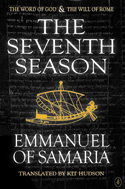When I finished the novel "The Midwife's Secret: The Mystery of the Hidden Princess" I knew the story was not truly finished, and that there was another character, a second Marguerite Kirkcaldy, a child born within weeks of her famous father's execution.
What would become of her? I asked, since history does not give provide so much as a clue other than a brief reference to the existence of a pretty laundress to whom he wrote love poems while awaiting execution - and who had given birth to his child.
The knight’s records were destroyed by his enemies and not even a notation of the child’s sex survives. It was all up to my imagination, and thus, a little girl named Daisy was born. Would she be guileless like her beautiful mother, or heroic and unpredictable like the knight Kirkcaldy of Grange? What would she do when she learned that there had been another Marguerite Kirkcaldy also nicknamed Daisy and claimed by Kirkcaldy as his love child?
The first Daisy had arrived mysteriously at the castle before the Lang Siege and disappeared under a cloud before it fell. Does Daisy have a hidden sister who was spirited away, or is there more to the story of the Other Daughter that even Daisy's mother is willing to disclose?
While Daisy approaches adulthood, weathering an infatuation with her flamboyant nephew, Sir Andrew Ker of Ferniehirst, and dealing with her attraction to the bastard of another controversial Scot, Will Hepburn, who is the 4th Earl of Bothwell’s son, will other rumors reach her ears? Could news of a beautiful Benedictine nun at Saint Pierre les Dames in Rheims called La Belle Écossaise but whose proper name is Sister Marguerite de’ Kircaldie drive Daisy from the secure life she leads in Canongate to a quest with implications touching the future of the Stuart dynasty?
While Daisy approaches adulthood, weathering an infatuation with her flamboyant nephew, Sir Andrew Ker of Ferniehirst, and dealing with her attraction to the bastard of another controversial Scot, Will Hepburn, who is the 4th Earl of Bothwell’s son, will other rumors reach her ears? Could news of a beautiful Benedictine nun at Saint Pierre les Dames in Rheims called La Belle Écossaise but whose proper name is Sister Marguerite de’ Kircaldie drive Daisy from the secure life she leads in Canongate to a quest with implications touching the future of the Stuart dynasty?
The challenge of a meeting of the Marguerites became irresistible, and Daisy's quest became my own.


























